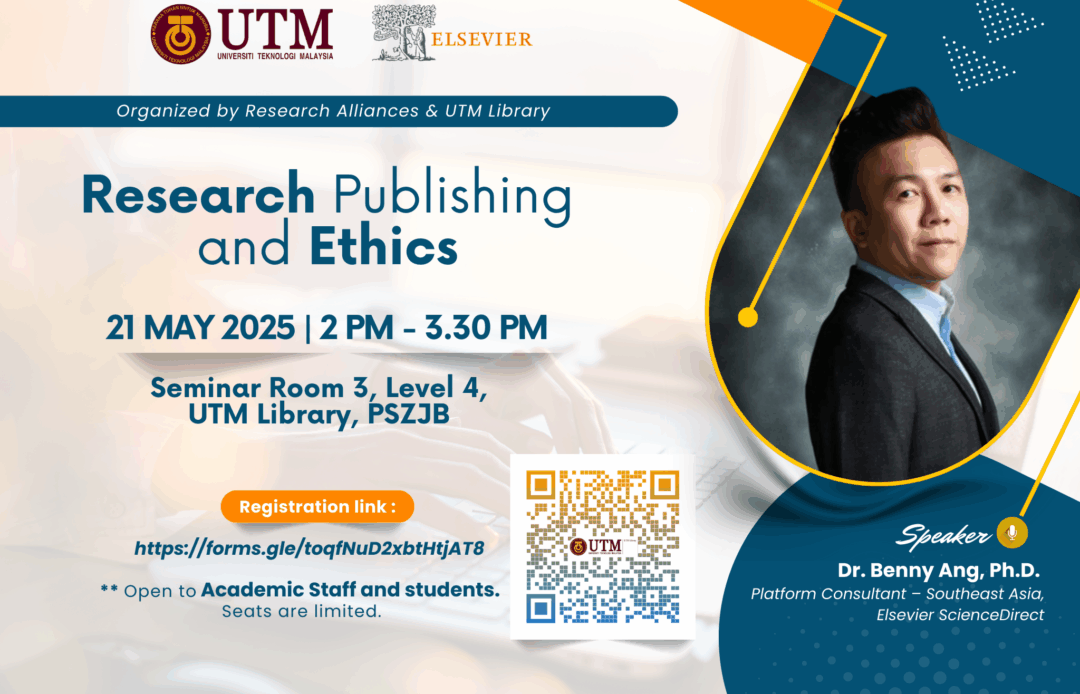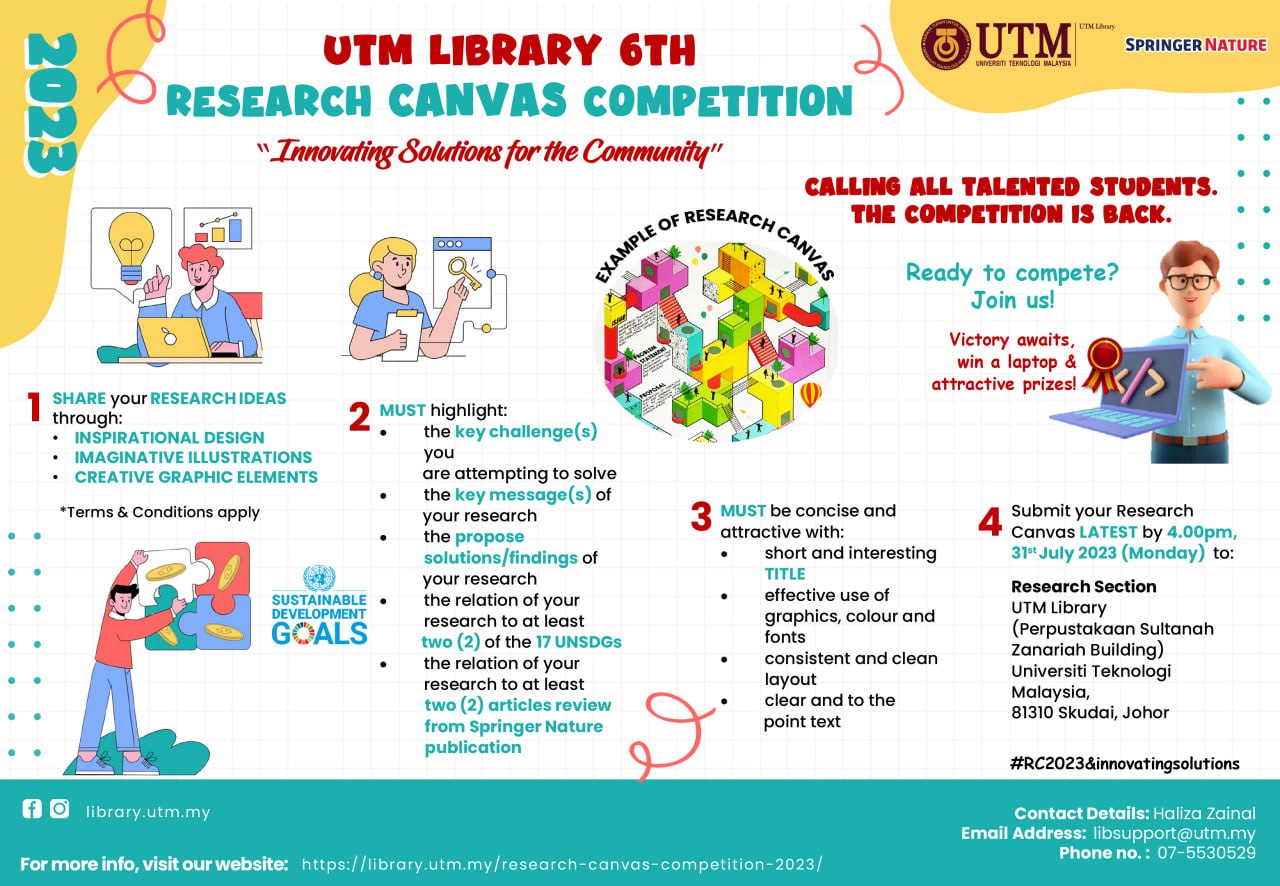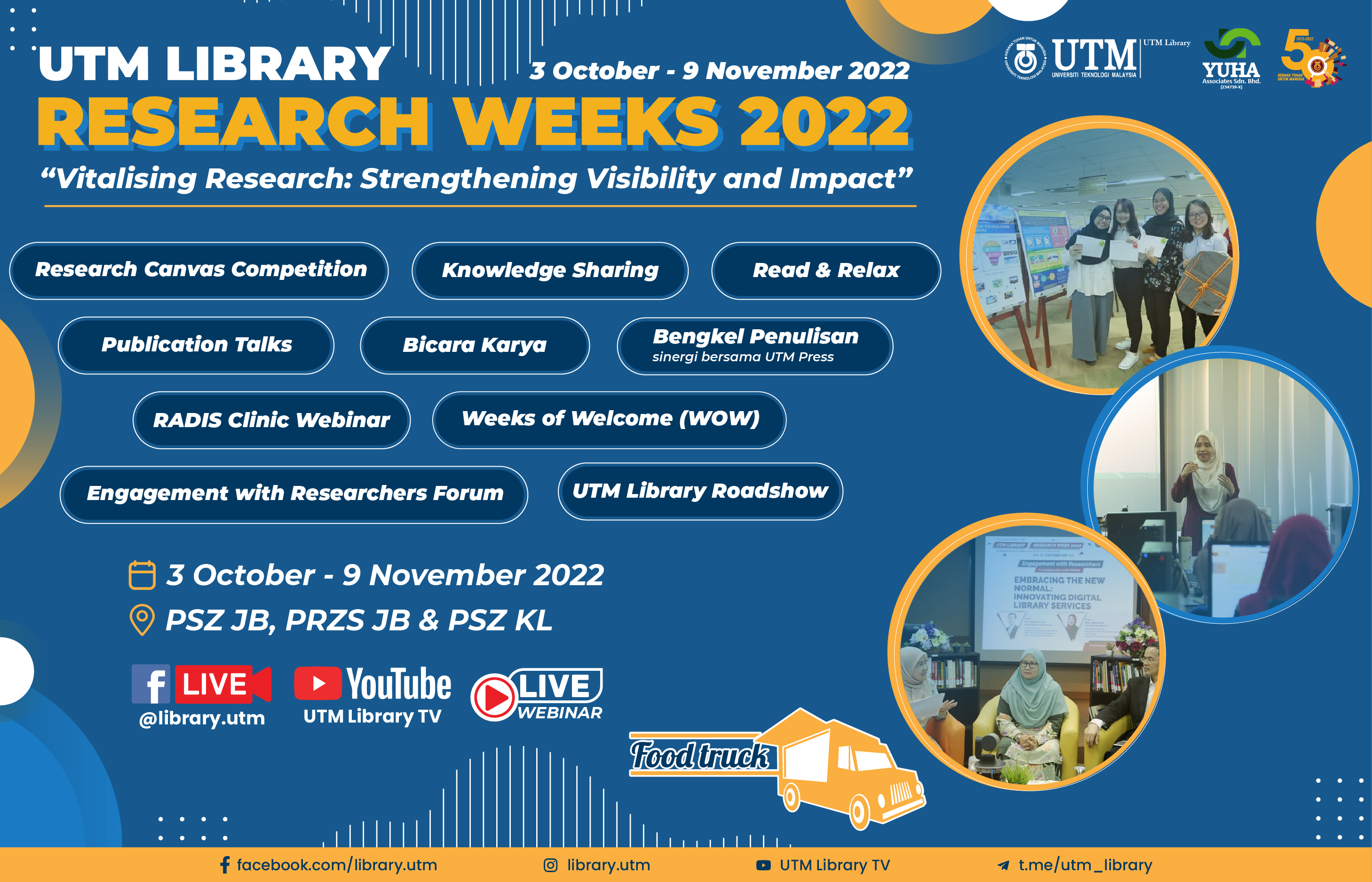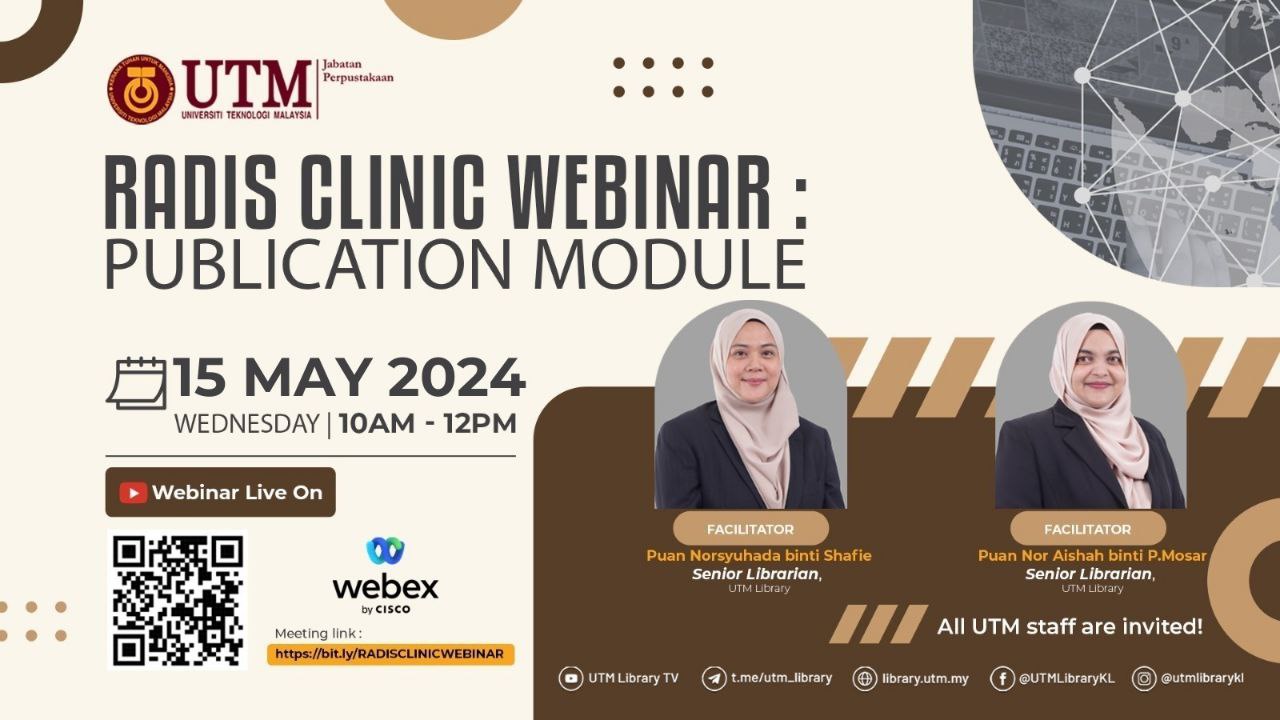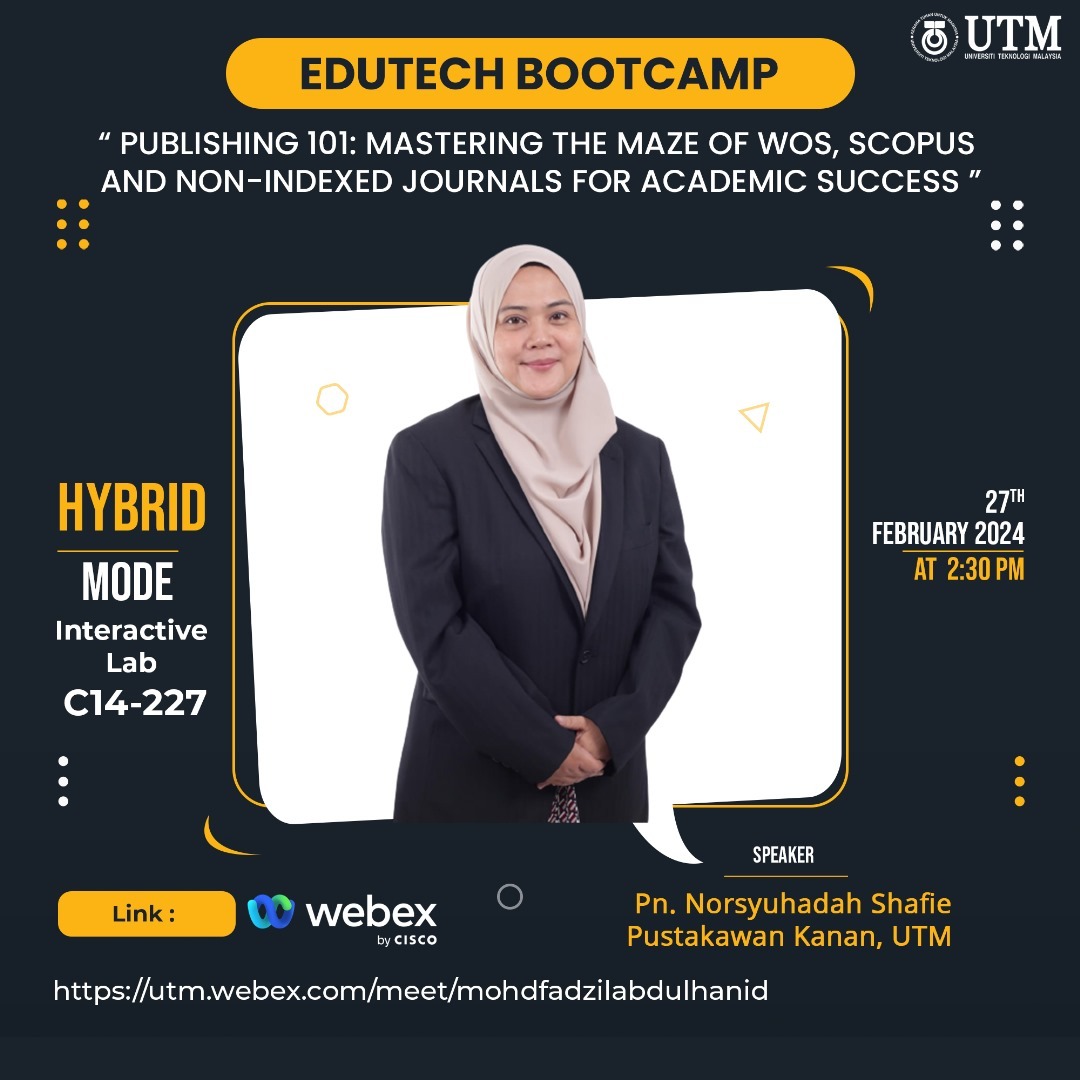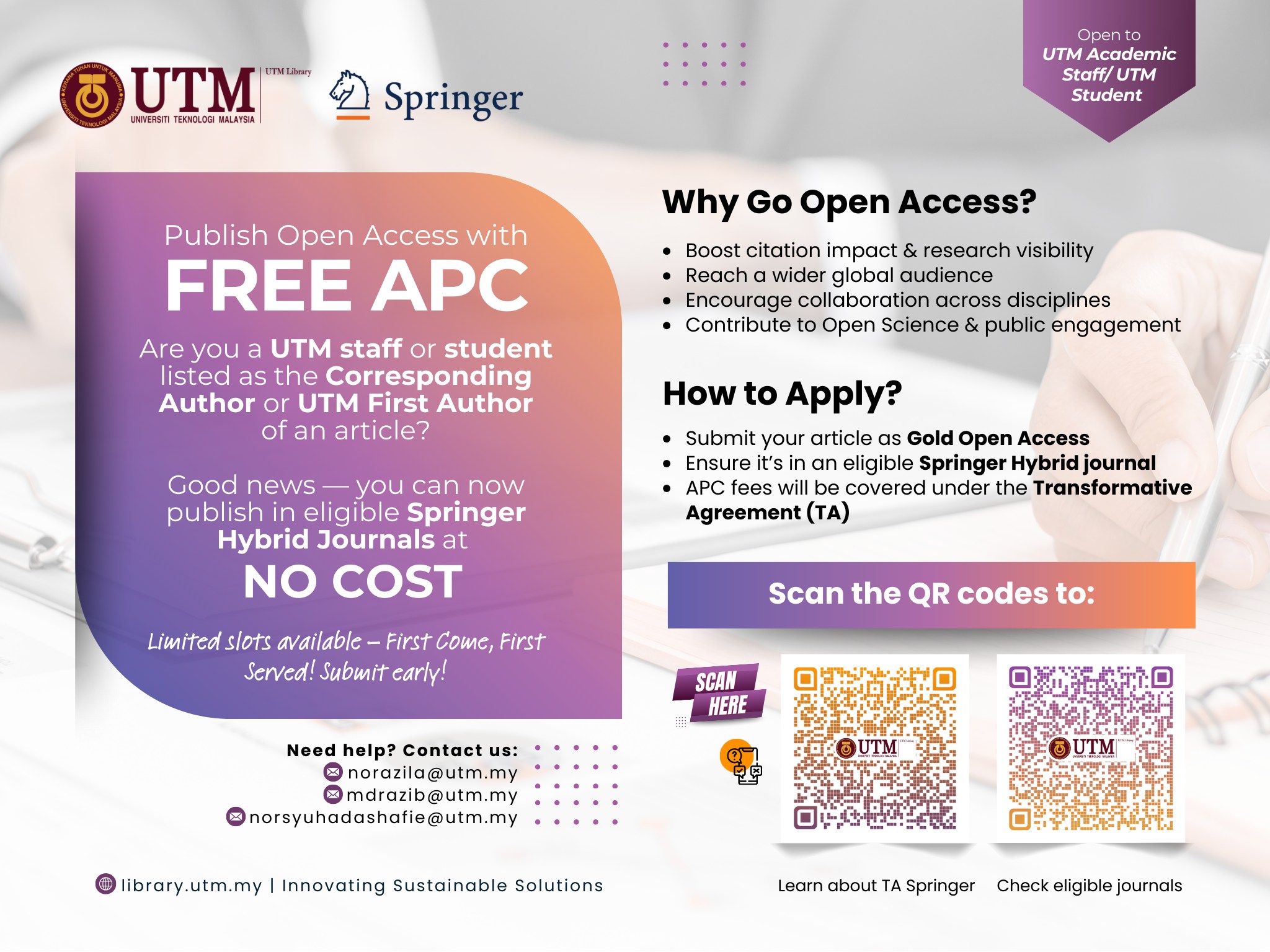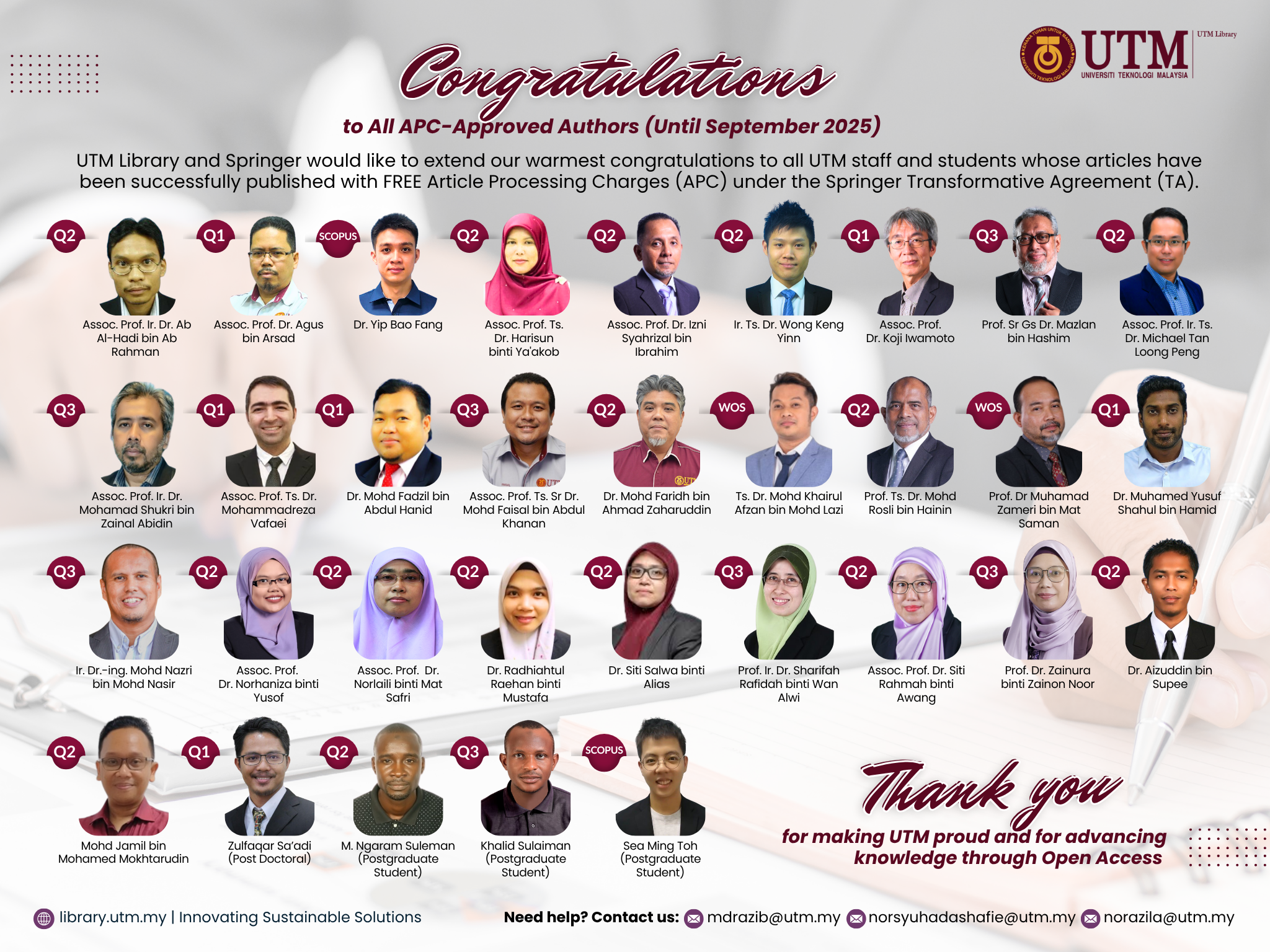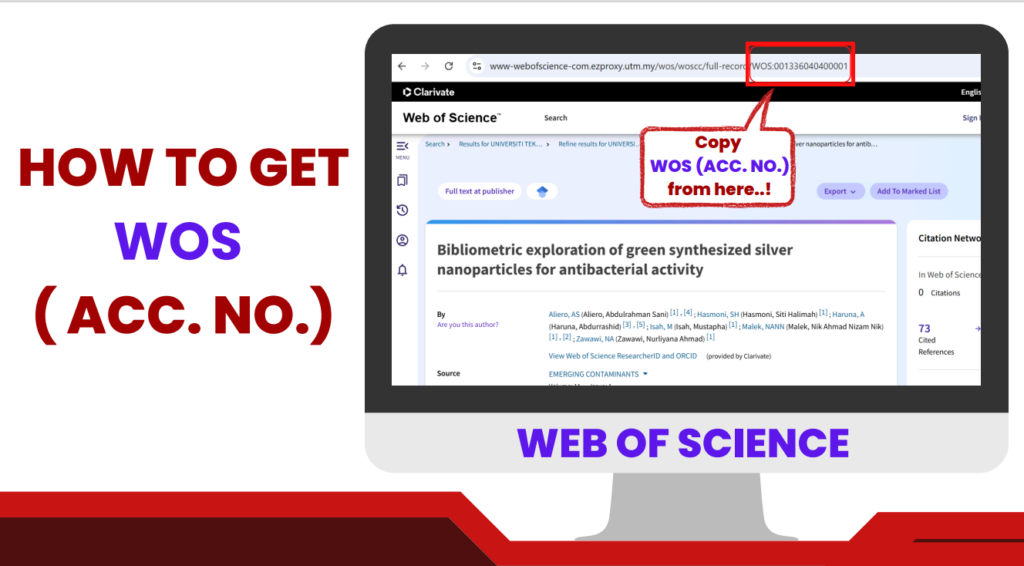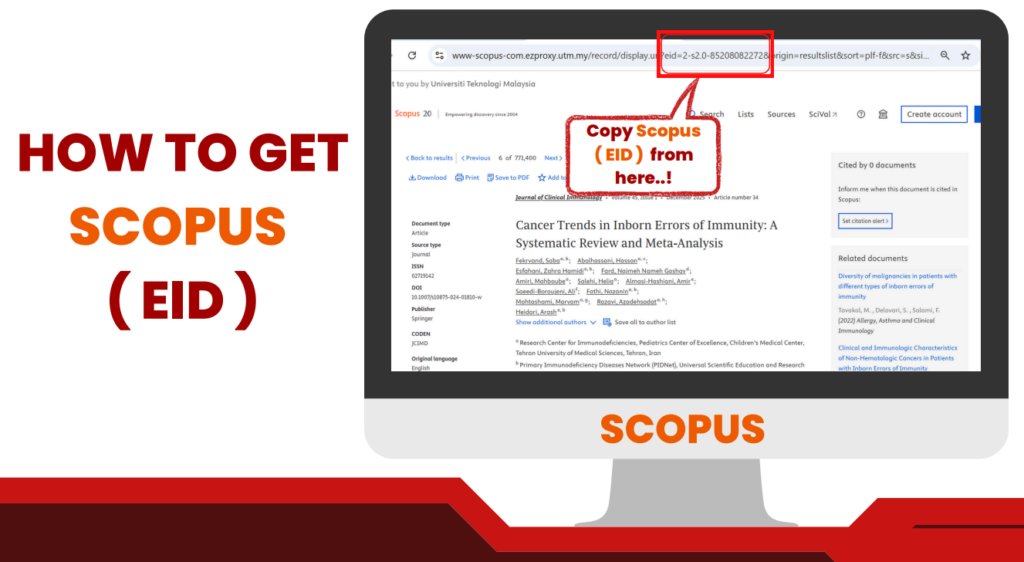UTM LIBRARY
RESEARCH SUPPORT PLATFORM
What is UTM Library Research Platform?
“A one-stop platform comprising research publication information, serving as a foundation for UTM researchers to produce impactful publications”
Indexed Publications
Web of Science
 The Web of Science Core Collection™ includes the Science Citation Index Expanded™ (SCIE), Social Sciences Citation Index™ (SSCI), Arts & Humanities Citation Index™ (AHCI), and Emerging Sources Citation Index™ (ESCI). Web of Science Core Collection includes only journals that demonstrate high levels of editorial rigor and best practice. The Journal Citation Reports™ includes journals from the SCIE and SSCI.
The Web of Science Core Collection™ includes the Science Citation Index Expanded™ (SCIE), Social Sciences Citation Index™ (SSCI), Arts & Humanities Citation Index™ (AHCI), and Emerging Sources Citation Index™ (ESCI). Web of Science Core Collection includes only journals that demonstrate high levels of editorial rigor and best practice. The Journal Citation Reports™ includes journals from the SCIE and SSCI.
To access a list of journals indexed in WOS, kindly log in to UTM Library EZProxy at http://ezproxy.utm.my/menu. Each collection list is downloadable from https://mjl.clarivate.com/collection-list-downloads. Although it’s free, please note that registration is necessary prior to downloading.
Scopus
 Scopus uniquely combines a comprehensive, expertly curated abstract and citation database with enriched data and linked scholarly literature across a wide variety of disciplines. Content types included on Scopus are either serial publications that have an ISSN (International Standard Serial Number) such as journals, book series and some conference series, or non-serial publications that have an ISBN (International Standard Book Number) like one-off book publications or one-off conferences.
Scopus uniquely combines a comprehensive, expertly curated abstract and citation database with enriched data and linked scholarly literature across a wide variety of disciplines. Content types included on Scopus are either serial publications that have an ISSN (International Standard Serial Number) such as journals, book series and some conference series, or non-serial publications that have an ISBN (International Standard Book Number) like one-off book publications or one-off conferences.
ERA
 The Australian Research Council (ARC) is responsible for administering Excellence in Research for Australia (ERA), Australia’s national research evaluation framework. ERA aims to identify and promote excellence across the full spectrum of research activity, including discovery, experimental and applied research within Australian higher education institutions. ERA 2023 will evaluate the quality of the research undertaken in eligible higher education providers institutions.
The Australian Research Council (ARC) is responsible for administering Excellence in Research for Australia (ERA), Australia’s national research evaluation framework. ERA aims to identify and promote excellence across the full spectrum of research activity, including discovery, experimental and applied research within Australian higher education institutions. ERA 2023 will evaluate the quality of the research undertaken in eligible higher education providers institutions.
MyCite
 Malaysia Citation Index or MyCite provides access to bibliographic as well full-text contents of scholarly journals published in Malaysia in the fields of Sciences, Technology, Medicine, Social Sciences and the Humanities. The journals indexed in MyCite might include Scopus & WOS indexed journals as well as non-indexed publication. The database is available for free at https://mycite.mohe.gov.my/
Malaysia Citation Index or MyCite provides access to bibliographic as well full-text contents of scholarly journals published in Malaysia in the fields of Sciences, Technology, Medicine, Social Sciences and the Humanities. The journals indexed in MyCite might include Scopus & WOS indexed journals as well as non-indexed publication. The database is available for free at https://mycite.mohe.gov.my/
Research Services
Research Week 2024
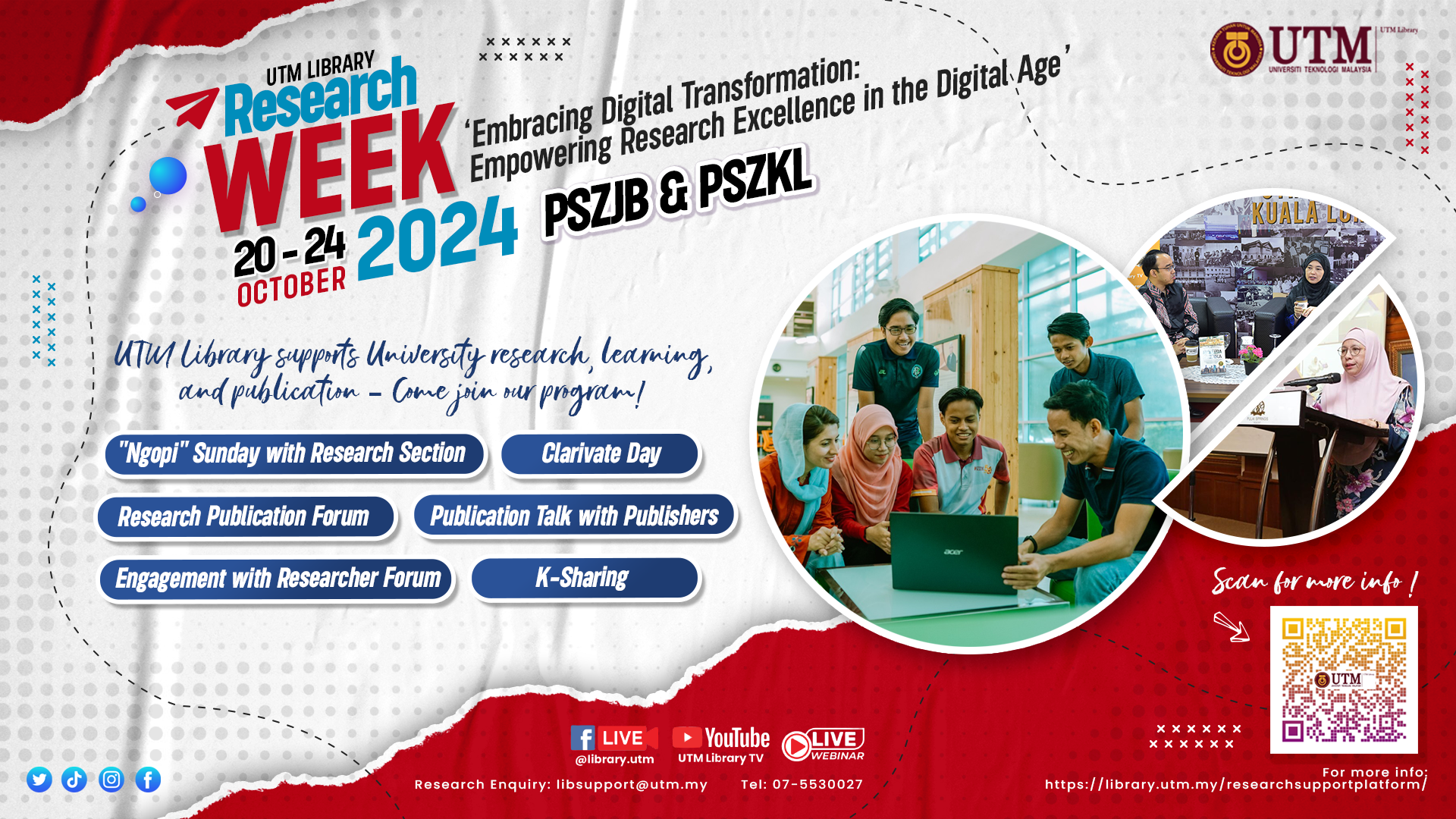
UTM Library is a vital institution supporting teaching, learning, and research by providing services and facilities tailored to current needs. It plays a proactive role in disseminating useful knowledge to the UTM community and the public, while also supporting university research and publishing activities. To further assist researchers, UTM Library will organize the UTM Library Research Week 2024 from 20th to 24th October 2024, with the theme ‘Embracing Digital Transformation: Empowering Research Excellence in the Digital Age’. This event aims to enhance collaboration among UTM researchers and lecturers while ensuring the availability of accurate information to produce high-impact research that benefits society.
Program Schedule

Research Activities
UTM Library regularly collaborates with academic publishers to organize research writing and academic publication workshop for researchers. Our past collaborators include Clarivate, Elsevier, Springer Nature, IEEE and many more.
If you are interested to join future workshops, please contact:
Ms. Haliza Zainal
Email: libsupport@utm.my
Tel: 07-553 0027
Publication Workshops
Other Activities
PUBLIC OPEN ACCESS WITH FREE APC (Springer TA)
QUICK LINKS
RADIS Publication
RADIS Publication Manual
- Registration (Academics)
- Verification (Library Staff)
- Incentive Claim
- Author Verification in RADIS
- 2024 Indexed Journals by Faculty
Polisi Penerbitan dan Insentif Penerbitan UTM
Research Guides
- Where to Publish?
- How to Check Quartile Information in WOS
- Checklist for Choosing a Legitimate / Quality Journal
- How to Spot Predatory Journals
- Phony vs Legit Publications
- Elsevier Researcher Academy
- What is Plagiarism?
- Scholarly vs Popular Articles
- Choosing the Right Journal for Publication
Research Impact & Visibility
Journal Finder
Researcher Profiles
RESEARCH TUTORIALS
Scopus Author ID
WOS Impact Factor & Quartile
SUBSCRIBED DATABASES
FAQs
What is Indexed Publication?
Indexation of a journal or indexed publications is considered a reflection of its quality. Indexed journals are considered to be of higher scientific quality as compared to non-indexed journals.
In the context of Malaysian Research Assessment, a journal is considered indexed when it is indexed in an abstract and citation database such as Web of Science (Clarivate Analytics), Scopus (Elsevier) or listed in ERA and MyCite.
What is MyCite?
MyCite is a Malaysian citation indexing system and a citation index database to increase the accessibility and visibility of Malaysian scholarly journals. It provides a yearly bibliometrics report on the performance of Malaysian journals that meet the quality criteria.
What is MyJurnal?
MyJurnal is an online system used by Citation and Infometric Division, MOHE to collect and index all the Malaysian journals. The Purpose of My Jurnal is to increase access, to encourage content usage and to improve visibility of the contents of Malaysian journals to the global community.
What is the Journal Impact Factor (JIF)?
The JCR provides quantitative tools for ranking, evaluating, categorizing, and comparing journals. The impact factor is one of these; it is a measure of the frequency with which the “average article” in a journal has been cited in a particular year or period. IF is awarded to the journals indexed in Thomson Reuters Journal Citation Reports. Interestingly, IF is not available for all indexed journals.
What is the Journal Citation Indicator (JCI)?
The Journal Citation Indicator is designed to complement the JIF – the original and longstanding metric for journal evaluation – and other metrics currently used in the research community. In addition to the use of normalization, there are several key differences between the Journal Citation Indicator and the JIF.
For example, the Journal Citation Indicator’s calculation on three years of publications contrasts with the two-year window employed for the JIF. This three-year calculation enables the Journal Citation Indicator to be as current as possible, while also allowing more time for publications to accrue citations.
What is Quartile Ranking?
Quartile rankings are derived for each journal in each of its Web of Science (WOS) subject categories. In Journal Citation Reports, the quartile rankings are defined based on rank for the Journal Impact Factor and it is defined as the following:
Q1: 0% < Z ≤ 25% Highest ranked journals in a category
Q2: 25% < Z ≤ 50%
Q3: 50% < Z ≤ 75%
Q4: 75% < Z Lowest ranked journals in a category
Which metric should be used to define journal Quartile and Impact Factor?
Refer to Journal Citation Report (JCR) by Clarivate Analytic to determine Quartile ranking and Impact Factor for a journal.
What is h-index?
h-index was proposed by J.E. Hirsch in 2005 and published in the Proceedings of the National Academy of Sciences of the United States of America. The h-index is a metric for evaluating the cumulative impact of an author’s scholarly output and performance; measures quantity with quality by comparing publications to citations. The h-index corrects for the disproportionate weight of highly cited publications or publications that have not yet been cited. Several resources automatically calculate the h index as part of citation reports for authors
What is Predatory Journal?
Predatory Journals take advantage of authors by asking them to publish for a fee without providing peer-review or editing services. Because predatory publishers do not follow the proper academic standards for publishing, they usually offer a quick turnaround on publishing a manuscript. In contrast, high quality academic journals take longer to publish articles because they go through a proper peer review and copy editing process.
How are predatory journals different than Open Access journals?
Open Access journals may solicit authors to publish for a fee, but maintain high standards for peer review and editing. The goal of Open Access publishing is to disseminate research to a larger audience by removing paywalls.
How can you spot a predatory journal?
1. Do you or your colleagues know the journal? Do you recognize the editorial board?
2. Can you easily contact the publisher?
3. Is the journal clear about their peer review process?
4. Is it clear what fees will be charged?
If the answer is no for any of these questions, the journal is most likely questionable, if not predatory.
How to determine the quartile ranking for publications?
Indicators for determining the JIF and ranking based on the publication month in the JCR:
- Publications in July 2022 – June 2023: IF & Quartile from JCR 2021
- Publications in July 2023 – June 2024: IF & Quartile from JCR 2022
- Publications in July 2024 – June 2025: IF & Quartile from JCR 2023
How to obtain the EID for WOS and Scopus No.?
Who is eligible for the Free APC under the Springer Transformative Agreement?
This benefit is available to all UTM academic staff and students listed as either the Corresponding Author or UTM First Author of an article.
Does the Free APC cover all journals in Springer?
No. The waiver applies only to eligible Springer Hybrid Journals listed under the Transformative Agreement (TA). You can check the full list of eligible journals via the QR code provided in the poster or through the UTM Research Support Platform.
What is a Hybrid Journal?
A Hybrid Journal publishes both subscription-based (closed access) and Open Access articles. Under the TA, your Open Access fee (APC) is covered if the journal is included in the eligible list.
How do I apply for the Free APC?
Follow these steps:
- Submit your article to a Springer Hybrid Journal.
- Choose Gold Open Access when prompted.
- Identify yourself using your UTM email address and affiliation during submission.
- Once your article is accepted, it will be verified under the UTM–Springer Transformative Agreement (TA), and the APC will be automatically covered.
Do I need to inform the Library after submission?
Yes, it is encouraged. Notify the Research Support Team once your article is accepted, so they can verify your eligibility and track the quota for APC-funded publications.
What if my article is rejected or withdrawn?
No APC will be charged unless the article is accepted and published. You may resubmit to another eligible journal within Springer if desired.
Does the Free APC cover all article types?
The waiver typically applies to original research articles, review papers, and brief communications. Editorials or book chapters may not be covered.
How many Free APC slots are available?
The number of APC-free slots is limited each year and offered on a first come, first served basis. Authors are encouraged to submit early to secure funding.
Are co-authored papers eligible if the Corresponding Author is not from UTM?
No. The Corresponding Author (or UTM First Author, if designated) must be affiliated with Universiti Teknologi Malaysia to qualify for the APC waiver.
What if my paper is accepted after the yearly quota is full?
If the APC quota is already used up for the year, authors will be notified. You may either: proceed with publication by paying the APC yourself, or choose non-open access publication (closed access).
What is the Transformative Agreement (TA)?
A Transformative Agreement is a contract between universities and publishers that transitions subscription-based publishing to Open Access, allowing authors to publish openly at no additional cost.
What are the benefits of publishing Open Access?
- Increases your research visibility and citation impact
- Reaches a global audience
- Promotes collaboration across disciplines
- Supports Open Science and public engagement
Who can I contact for help?
For inquiries or assistance, contact the Research Support Team: norazila@utm.my

RESEARCH SUPPORT UNIT
UTM Library
Bangunan Perpustakaan Sultanah Zanariah
Tel: 07-5530016
Research Enquiry: libsupport@utm.my

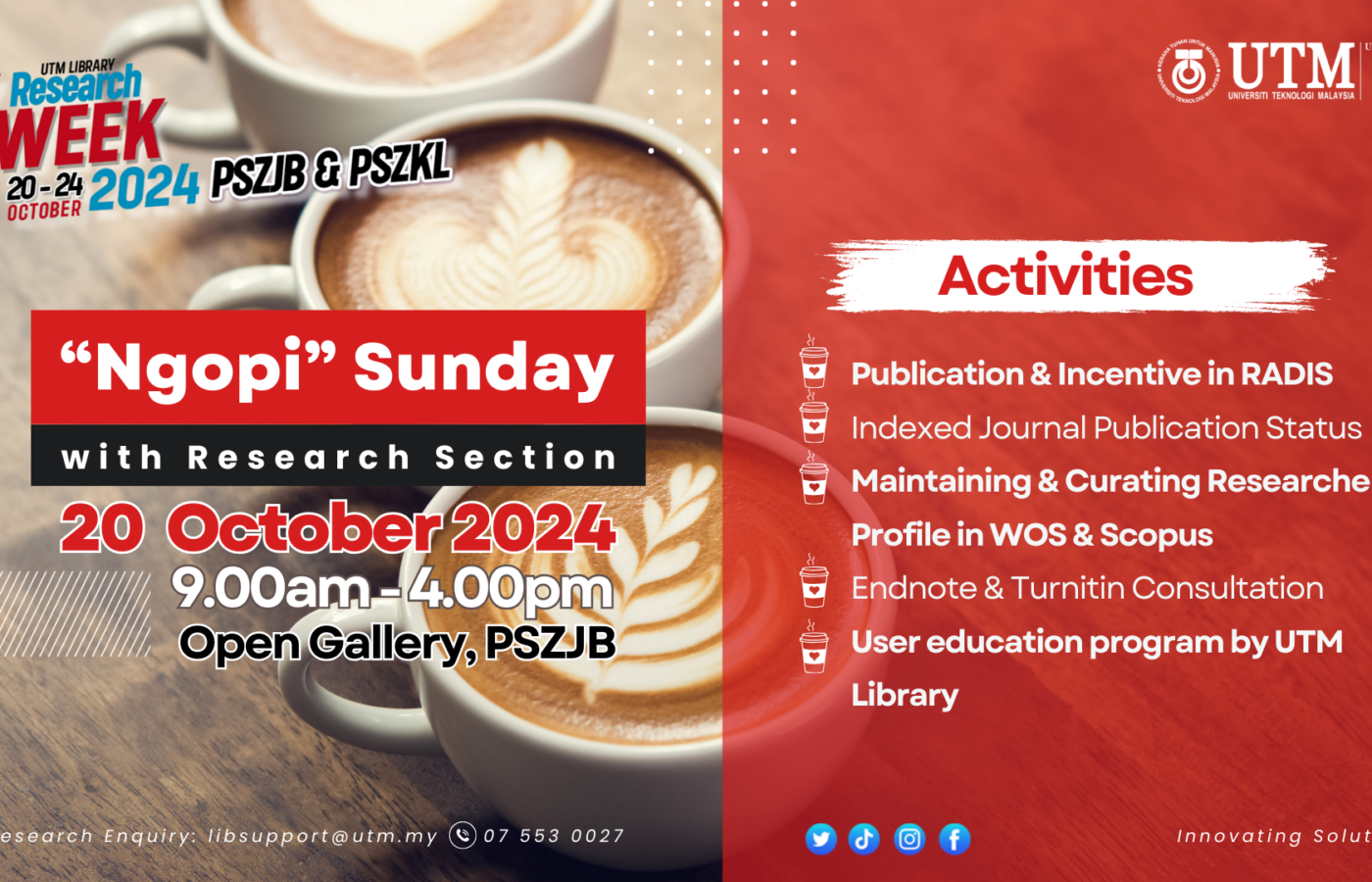

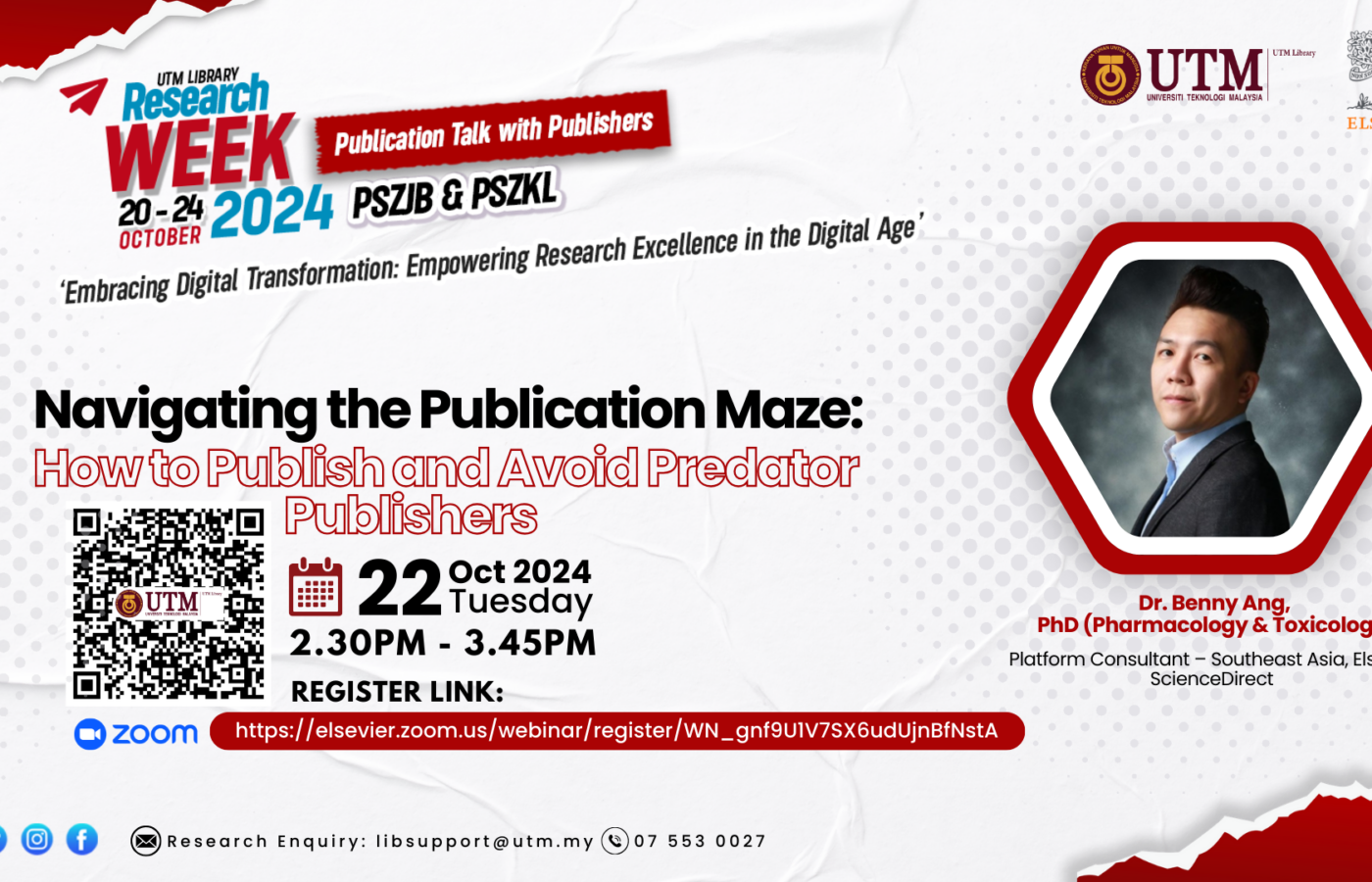

![5] engagement w researchers](https://library.utm.my/wp-content/uploads/2024/10/5-engagement-w-researchers-1078x693.jpg)
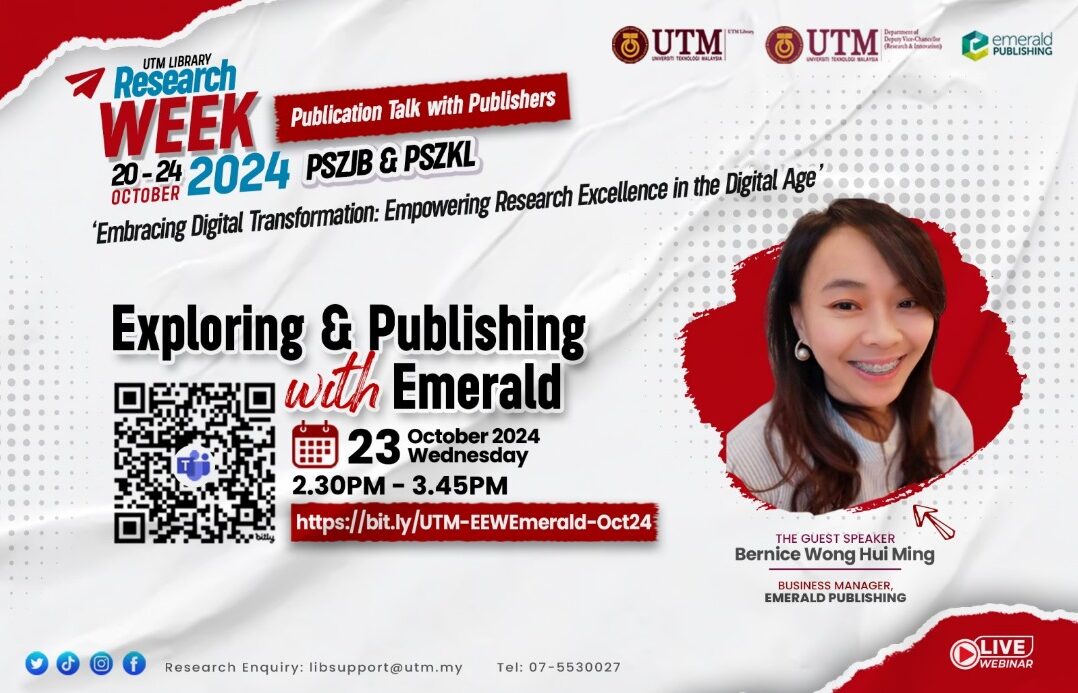
![7] ksharing](https://library.utm.my/wp-content/uploads/2024/10/7-ksharing-1078x693.jpg)

